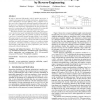Free Online Productivity Tools
i2Speak
i2Symbol
i2OCR
iTex2Img
iWeb2Print
iWeb2Shot
i2Type
iPdf2Split
iPdf2Merge
i2Bopomofo
i2Arabic
i2Style
i2Image
i2PDF
iLatex2Rtf
Sci2ools
PLDI
2006
ACM
2006
ACM
Automatic instruction scheduler retargeting by reverse-engineering
In order to generate high-quality code for modern processors, a compiler must aggressively schedule instructions, maximizing resource utilization for execution efficiency. For a compiler to produce such code, it must avoid structural hazards by being aware of the processor’s available resources and of how these resources are utilized by each instruction. Unfortunately, the most prevalent approach to constructing such a scheduler, manually discovering and specifying this information, is both tedious and error-prone. This paper presents a new approach which, when given a processor or processor model, automatically determines this information. After establishing that the problem of perfectly determining a processor’s structural hazards through probing is not solvable, this paper proposes a heuristic algorithm that discovers most of this information in practice. This can be used either to alleviate the problems associated with manual creation or to verify an existing specification. ...
PLDI 2006 | Processor’s Available Resources | Processor’s Structural Hazards | Programming Languages | Structural Hazard |
| Added | 14 Jun 2010 |
| Updated | 14 Jun 2010 |
| Type | Conference |
| Year | 2006 |
| Where | PLDI |
| Authors | Matthew J. Bridges, Neil Vachharajani, Guilherme Ottoni, David I. August |
Comments (0)

